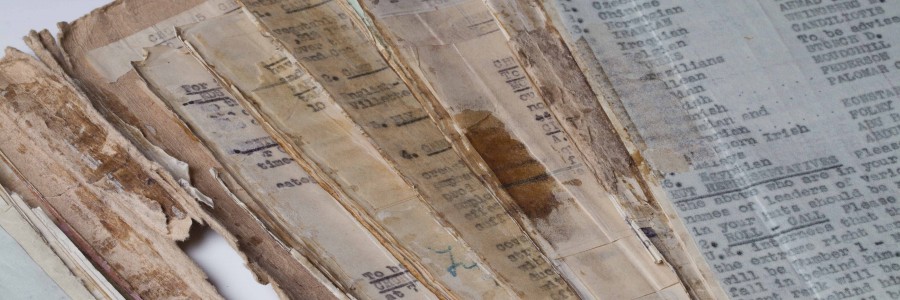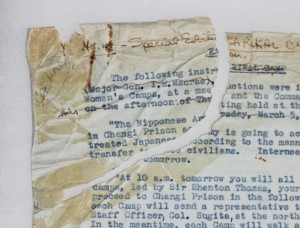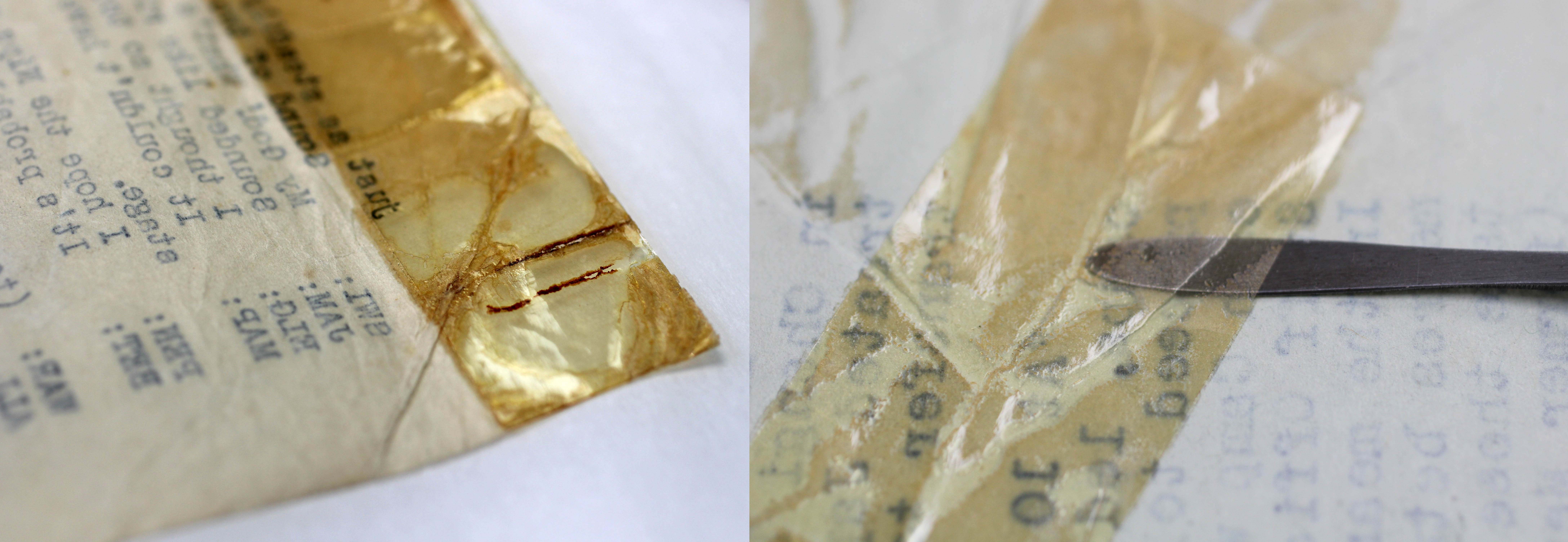
Conservation Challenges posed by the Changi Archive
by Emma Nichols and Mary French
The conservation of the WWII Changi civilian internment camp archives is being undertaken by two conservators, Emma Nichols and Mary French, over ten months between October 2015 and July 2016. The conservators are being funded by the Wellcome Trust. Both conservators have worked as Book & Paper Conservators at Cambridge University Library for the past two years and previously worked together conserving paper and parchment fragments of the Lewis-Gibson Collection from the Cairo Genizah. Conserving a large scale body of work such as the Lewis-Gibson Collection has provided the conservators with valuable experience when it comes to tackling a project such as the Changi archives.
Conservation Aims
The aims of conservation are to stabilise, clean and repair the items to enable them to be safely handled for digitisation. The items are being conserved in work packages of approximately 200 to 1,000 leaves at a time. Once a month, when each work package is complete, it will be taken to the Digital Content Unit to be imaged. Interim housing is being made to enable safe transport, handling and storage of items between conservation and digitisation. Longer term storage solutions will be designed post digitisation.
Conservation Challenges
The materials in the Changi archives pose a number of challenges to the conservator due to several different factors. 20th century materials, like the ones in this collection, are generally cheaply made and tend to degrade quickly. The fact that a lot of the papers had already been used once or even twice before they came into the hands of the internees means many had already suffered damage. The archive is made up of loose leaves of paper, some of which have been adhered or ‘tipped’ to each other or held together by staples, pins, and paper clips, as well as pamphlets and bindings. Tipping and stapling leaves together has resulted in the contents being obscured and the fragile paper has sustained tears and losses during use. This means the contents cannot be accessed by readers and prevents safe and successful digitisation.
A lot of the typewritten material is printed on onionskin paper, which is so named not because it is made from onions, but as it superficially resembles the skin of an onion due to its thin, lightweight and translucent qualities. Onionskin paper tears very easily and can be problematic to treat due to its fragility.
Another problematic material found frequently in the archive is pressure sensitive tape. Colloquially known as Sellotape, pressure sensitive tapes were applied to items with the original intention to repair tears or to hold bundles of items together. The application of pressure sensitive tape works as a quick fix, but in the longer term causes more harm than good. As the adhesive of the tape ages it degrades, shrinks and causes areas of tension which result in brittleness and tears. The plastic carrier starts to detach and the adhesive can start to crosslink, causing staining and translucency in the paper. The tape carrier and any sticky surface residue will be removed and stabilised where possible.
The camp’s nominal rolls are two books which have suffered water damage. This has led to the paper and bindings suffering extensive mould damage, which in turn has caused staining and weakening of the paper leaves. The bindings and leaves will be cleaned and repaired resulting in them being able to be handled safely and with confidence.

(L) Detail of board damage to one of the two Nominal Rolls (R) Detail of mould and water damage to Nominal Roll
Treatment Process
Prior to carrying out treatments, items are photographed by the conservators to provide a record of damage and document the order of leaves to be separated. Inks are tested for friability and fugitivity to make sure that any cleaning or repair work carried out won’t cause the pigments to flake away or bleed when exposed to moisture. Items will be dry cleaned where there is surface dirt. Paper repairs will generally be done with a 2.5gsm re-moistenable tissue and any infills needed will be carried out with various weights of lightweight conservation repair tissue and wheat starch paste.
As the project progresses, we look forward to sharing more blog posts about the conservation of the collection and any interesting items we come across.







Pingback: Changi digitisation project at Cambridge University Library | Southeast Asia Library Group (SEALG)
Pingback: Changi digitisation project at Cambridge University Library | …a handful of ashes…
Pingback: Changi digitisation project: Cambridge | Researching FEPOW History
Great work team, thank you so much for so many, that you are restoring and keeping these records safe. Look forward to viewing them on the internet too.
Pingback: Vol. 9, no. 12 | I-Heritage.info